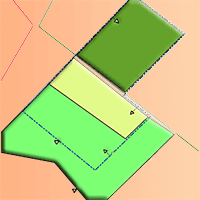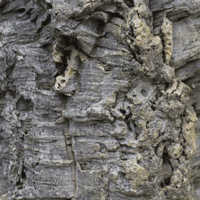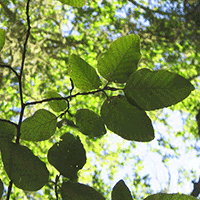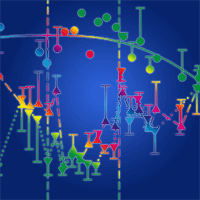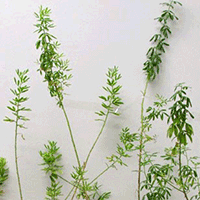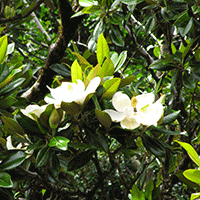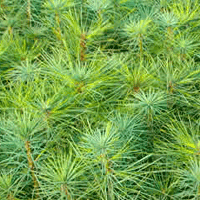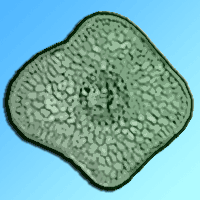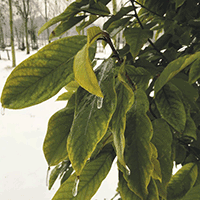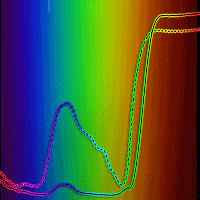The study investigates the impact of varying environmental treatments on the needle morphology, chemistry, and photosynthetic performance of Silver fir (Abies alba), Norway spruce (Picea abies), and Scots pine (Pinus sylvestris) undergrowth in a birch (Betula pendula)-dominated young forest. The experiment analyzed the effects of different levels of birch canopy reduction. The treatments included a birch preparatory stand managed through positive tending of promising birch trees (PS), a restored small clearing (RC), and a former clearing overgrown by birch sprouts (OC), while the control treatment was left unmanaged. The aim was to evaluate the rate of adaptation to irradiation changes among these species. Fir and pine exhibited significant needle morphological changes within the first year after canopy opening, while spruce needles remained relatively stable. In the first year after release, pine and fir new needles in the RC treatment had reduced K (and Mg in fir), while spruce needles increased N and Ca concentrations. Chlorophyll a fluorescence measurements indicated that photosynthetic efficiency tended to slightly decrease across all species when exposed to higher irradiance. The results show high plasticity of the species in response to the changes in light conditions of the nurse stand. The means of the adaptation were specific for each species, but the new conditions did not limit the adaptation potential for any of them.
Keywords
, , , , , ,
Citation
Špulák O (2025). Needle traits of understory Silver fir, Norway spruce, and Scots pine in response to increased canopy openness in a birch-dominated stand. iForest 18: 273-282. - doi: 10.3832/ifor4909-018
Academic Editor
Claudia Cocozza
Paper history
Received: May 27, 2025
Accepted: Sep 16, 2025
First online: Oct 14, 2025
Publication Date: Oct 31, 2025
Publication Time: 0.93 months
© SISEF - The Italian Society of Silviculture and Forest Ecology 2025
Open Access
This article is distributed under the terms of the Creative Commons Attribution-Non Commercial 4.0 International (https://creativecommons.org/licenses/by-nc/4.0/), which permits unrestricted use, distribution, and reproduction in any medium, provided you give appropriate credit to the original author(s) and the source, provide a link to the Creative Commons license, and indicate if changes were made.

Breakdown by View Type
(Waiting for server response...)
Article Usage
Total Article Views: 895
(from publication date up to now)
Breakdown by View Type
HTML Page Views: 281
Abstract Page Views: 284
PDF Downloads: 293
Citation/Reference Downloads: 0
XML Downloads: 37
Web Metrics
Days since publication: 52
Overall contacts: 895
Avg. contacts per week: 120.48
Article Citations
Article citations are based on data periodically collected from the Clarivate Web of Science web site
(last update: Mar 2025)
(No citations were found up to date. Please come back later)
Publication Metrics
by Dimensions ©
Articles citing this article
List of the papers citing this article based on CrossRef Cited-by.
(1)
Annighöfer P (2018)Stress relief through gap creation? Growth response of a shade-tolerant species (
Fagus sylvatica L.) to a changed light environment. Forest Ecology and Management 415-416: 139-147.
CrossRef |
Gscholar
(2)
Aussenac G (2000)Interactions between forest stands and microclimate: ecophysiological aspects and consequences for silviculture. Annals of Forest Science 57 (3): 287-301.
CrossRef |
Gscholar
(3)
Beckschäfer P (2015)Hemispherical_2.0 - Batch processing hemispherical and canopy photographs with ImageJ - User Manual. Chair of Forest Inventory and Remote Sensing, Georg-August-Universität Göttingen, Germany.
Online |
Gscholar
(4)
Brang P, Spathelf P, Larsen JB, Bauhus J, Boncìna A, Chauvin C (2014)Suitability of close-to-nature silviculture for adapting temperate European forests to climate change. Forestry 87 (4): 492-503.
CrossRef |
Gscholar
(5)
Brichta J, Kuneš I, Linda R, Vítámvás J (2020)Does shelterwood regeneration on natural Scots pine sites under changing environmental conditions represent a viable alternative to traditional clear-cut management? Central European Forestry Journal 66 (2): 104-115.
CrossRef |
Gscholar
(6)
Bussotti F (2008)Functional leaf traits, plant communities and acclimation processes in relation to oxidative stress in trees: a critical overview. Global Change Biology 14 (11): 2727-2739.
CrossRef |
Gscholar
(7)
Cater M, Diaci J (2017)Divergent response of European beech, silver fir and Norway spruce advance regeneration to increased light levels following natural disturbance. Forest Ecology and Management 399 (3): 206-212.
CrossRef |
Gscholar
(8)
Cater M, Simoncic P (2010)Root distribution of under-planted European beech (
Fagus sylvatica L.) below the canopy of a mature Norway spruce stand as a function of light. European Journal of Forest Research 129 (4): 541-541.
CrossRef |
Gscholar
(9)
Dobrowolska D, Boncina A, Klumpp R (2017)Ecology and silviculture of silver fir (
Abies alba Mill.): a review. Journal of Forest Research 22 (6): 326-335.
CrossRef |
Gscholar
(10)
Durand M, Murchie EH, Lindfors AV, Urban O, Aphalo PJ, Robson TM (2021)Diffuse solar radiation and canopy photosynthesis in a changing environment. Agricultural and Forest Meteorology 311 (42): 108684.
CrossRef |
Gscholar
(11)
Fiorucci AS, Fankhauser C (2017)Plant strategies for enhancing access to sunlight. Current Biology 27 (17): R931-R940.
CrossRef |
Gscholar
(12)
Flerchinger GN, Reba ML, Link TE, Marks D (2015)Modeling temperature and humidity profiles within forest canopies. Agricultural and Forest Meteorology 213 (1-2): 251-262.
CrossRef |
Gscholar
(13)
Gaweda T, Malek S, Blonska E, Jagodzinski AM, Bijak S, Zasada M (2021)Macro and micronutrient contents in soils of a chronosequence of naturally regenerated birch stands on abandoned agricultural lands in central Poland. Forests 12 (7): 956.
CrossRef |
Gscholar
(14)
Giuliani R, Magnanini E, Fragassa C, Nerozzi F (2000)Ground monitoring the light-shadow windows of a tree canopy to yield canopy light interception and morphological traits. Plant, Cell and Environment 23 (8): 783-796.
CrossRef |
Gscholar
(15)
Hale SE (2003)The effect of thinning intensity on the below-canopy light environment in a Sitka spruce plantation. Forest Ecology and Management 179 (1-3): 341-349.
CrossRef |
Gscholar
(16)
Hurt V, Mauer O (2016)Podsadby prípravných porostu brízy belokoré, olše a jerábu ptačího bukem lesním a jedlí belokorou. Certifikovaná metodika [Underplanting European beech and silver fir in the preparatory forest stands of European white birch, alder and European mountain ash]. Mendelova univerzita, Brno, Czech Republic, pp. 40. [in Czech]
Gscholar
(17)
Hytönen J (2019)Stump diameter and age affect coppicing of downy birch (
Betula pubescens Ehrh.). European Journal of Forest Research 138 (2): 345-352.
CrossRef |
Gscholar
(18)
Jandl R, Spathelf P, Bolte A, Prescott CE (2019)Forest adaptation to climate change - Is non-management an option? Annals of Forest Science 76 (2): 95.
CrossRef |
Gscholar
(19)
Knapp BO, Wang GG, Walker JL, Hu H (2016)Using silvicultural practices to regulate competition, resource availability, and growing conditions for
Pinus palustris seedlings underplanted in
Pinus taeda forests. Canadian Journal of Forest Research 46 (7): 902-913.
CrossRef |
Gscholar
(20)
Lhotka JM, Loewenstein EF (2008)Influence of canopy structure on the survival and growth of underplanted seedlings. New Forest 35 (1): 89-104.
CrossRef |
Gscholar
(21)
Lichtenthaler HK, Ač A, Marek MV, Kalina J, Urban O (2007)Differences in pigment composition, photosynthetic rates and chlorophyll fluorescence images of sun and shade leaves of four species. Plant Physiology and Biochemistry 45 (8): 577-588.
CrossRef |
Gscholar
(22)
Löf M, Karlsson M, Sonesson K, Welander T, Collet C (2007)Growth and mortality in underplanted tree seedlings in response to variation in canopy closure of Norway spruce stands. Forestry 80: 371-383.
CrossRef |
Gscholar
(23)
Maxwell K, Johnson GN (2000)Chlorophyll fluorescence a practical guide. Journal of Experimental Botany 51 (345): 659-668.
CrossRef |
Gscholar
(24)
Mehlich A (1984)Mehlich 3 soil test extractant. A modification of the Mehlich 2 extractant. Communications in Soil Science and Plant Analysis 15: 1409-1416.
CrossRef |
Gscholar
(25)
Messier C, Bauhus J, Sousa-Silva R, Auge H, Baeten L, Barsoum N, Bruelheide H, Caldwell B, Cavender-Bares J, Dhiedt E, Eisenhauer N, Ganade G, Gravel D, Guillemot J, Hall JS, Hector A, Hérault B, Jactel H, Koricheva J, Kreft H, Mereu S, Muys B, Nock CA, Paquette A, Parker JD, Perring MP, Ponette Q, Potvin C, Reich PB, Scherer-Lorenzen M, Schnabel F, Verheyen K, Weih M, Wollni M, Zemp DC (2022)For the sake of resilience and multifunctionality, let’s diversify planted forests! Conservation Letters 15 (1): e12829.
CrossRef |
Gscholar
(26)
Modry M, Hubeny D, Rejsek K (2004)Differential response of naturally regenerated European shade-tolerant tree species to soil type and light availability. Forest Ecology and Management 188 (1-3): 185-195.
CrossRef |
Gscholar
(27)
Niinemets U, Ellsworth DS, Lukjanova A, Tobias M (2001)Site fertility and the morphological and photosynthetic acclimation of needles to light. Tree Physiology 21 (17): 1231-1244.
CrossRef |
Gscholar
(28)
Niyogi KK (1999)Photoprotection revisited: genetic and molecular approaches. Annual Review of Plant Physiology and Plant Molecular Biology 50 (1): 333-359.
CrossRef |
Gscholar
(29)
Panferov O, Knyazikhin Y, Myneni R, Szarzynski J, Engwald S, Schnitzler K, Gravenhorst G (2001)The role of canopy structure in the spectral variation of transmission and absorption of solar radiation in vegetation canopies. IEEE Transactions on Geoscience and Remote Sensing 39 (2): 241-253.
CrossRef |
Gscholar
(30)
Polách R, Špulák O (2022)Prosperita jedle v podsadbách pod prípravnými porosty listnatých drevin o ruzném zakmenení a veku [Prosperity of silver fir planted under preparatory stands of pioneer broadleaves of different stocking and age]. Reports of Forestry Research/Zprávy Lesnického Výzkumu 67 (4): 269-277. [in Czech]
Online |
Gscholar
(31)
Presscot CE (2002)The influence of the forest canopy on nutrient cycling. Tree Physiology 22 (15-16): 1193-1200.
CrossRef |
Gscholar
(32)
Prewitt JMS, Mendelsohn ML (1966)The analysis of cell images. Annals of the New York Academy of Sciences 128 (3): 1035-1053.
CrossRef |
Gscholar
(33)
R Core Team (2024)R: a language and environment for statistical computing. R Foundation for Statistical Computing, Vienna, Austria.
Online |
Gscholar
(34)
Renaud V, Rebetez M (2009)Comparison between open-site and below-canopy climatic conditions in Switzerland during the exceptionally hot summer of 2003. Agricultural and Forest Meteorology 149 (5): 873-880.
CrossRef |
Gscholar
(35)
Reynolds PE, Simpson JA, Lautenschlager RA, Bell FW, Gordon AM, Buckley DA, Gresch A (1997)Alternative conifer release treatments affect below and near-ground microclimate. Forest Chronicles 73 (1): 75-82.
CrossRef |
Gscholar
(36)
Riikonen J, Kettunen N, Gritsevich M, Hakala T, Särkkä L, Tahvonen R (2016)Growth and development of Norway spruce and Scots pine seedlings under different light spectra. Environmental and Experimental Botany 121: 112-120.
CrossRef |
Gscholar
(37)
Robakowski P, Antczak P (2008)Ability of silver fir and European beech saplings to acclimate photochemical processes to the light environment under different canopies of trees. Polish Journal of Ecology 56: 3-16.
Online |
Gscholar
(38)
Sercu BK, Baeten L, Van Coillie F (2017)How tree species identity and diversity affect light transmittance to the understory in mature temperate forests. Ecology and Evolution 7 (24): 10861-10870.
CrossRef |
Gscholar
(39)
Sottosanti K (2023)Pioneer species. Encyclopedia Britannica, website.
Online |
Gscholar
(40)
Souček J, Špulák O, Leugner J, Pulkrab K (2016)Dvoufázová obnova lesa na kalamitních holinách s využitím prípravných drevin. Certifikovaná metodika [Two-phase regeneration of forest stand on large calamity originated clear-cuts with utilisation of nurse stand]. Výzkumný ústav lesního hospodárství a myslivosti, Strnady, Czech Republic, pp. 35. [in Czech]
Gscholar
(41)
Sprugel D, Brooks JR, Hinckley T (1996)Effect of light on shoot and needle morphology in
Abies amabilis. Tree Physiology 16 (1-2): 91-98.
CrossRef |
Gscholar
(42)
Špulák O (2008)Assimilation apparatus variability of beech transplants grown in variable light conditions of blue spruce shelter. Journal of Forest Science 54 (11): 491-496.
CrossRef |
Gscholar
(43)
Špulák O, Souček J, Leugner J (2016)Nadzemní biomasa, živiny a spalné teplo v mladém sukcesním porostu prípravných drevin [Aboveground biomass, nutrients and combustion heat of young successional forest stand of pioneer species]. Reports of Forestry Research/Zprávy Lesnického Výzkumu 61 (2): 132-137. [in Czech]
Online |
Gscholar
(44)
Stein WI, Slabaugh PE, Plummer AP (1974)Harvesting, processing, and storage of fruits and seeds. In: “Seeds of woody plants in the United States” (Schopmeyer CS ed). Agricultural Handbook no. 450, USDA Forest Service, Washington, DC, USA, pp. 98-125.
Gscholar
(45)
Stenberg P, Linder S, Smolander H, Flower-Ellis J (1994)Performance of the LAI-2000 plant canopy analyzer in estimating leaf area index of some Scots pine stands. Tree Physiology 14 (7-8-9): 981-995.
CrossRef |
Gscholar
(46)
Stokes V, Kerr G, Connolly T (2021)Underplanting is a practical silvicultural method for regenerating and diversifying conifer stands in Britain. Forestry 94 (2): 219-231.
CrossRef |
Gscholar
(47)
Strasser RJ, Tsimilli-Michael M, Srivastava A (2004)Analysis of the chlorophyll a fluorescence transient. In: “Chlorophyll
a Fluorescence: a Signature of Photosynthesis” (Papageorgiou GC, Govindjee eds). Advances in Photosynthesis and Respiration, Vol. 19, pp. 321-362.
CrossRef |
Gscholar
(48)
Swoczyna T, Kalaji HM, Bussotti F, Mojski J, Pollastrini M (2022)Environmental stress - what can we learn from chlorophyll
a fluorescence analysis in woody plants? A review. Frontiers in Plant Science 13: 208.
CrossRef |
Gscholar
(49)
Takahashi S, Murata N (2008)How do environmental stresses accelerate photoinhibition?Trends in Plant Science 13 (4): 178-182.
CrossRef |
Gscholar
(50)
Tiebel K, Huth F, Wagner S (2018)Soil seed banks of pioneer tree species in European temperate forests: a review. iForest - Biogeosciences and Forestry 11 (1): 48-57.
CrossRef |
Gscholar
(51)
UNECE (1998)International co-operative programme on assessment and monitoring of air pollution effects on forests. Manual on methods and criteria for harmonized sampling, assessment, monitoring and analysis of the effects of air pollution on forests (4th edn). Federal Research Centre for Forestry and Forest Products - BFH, Hamburg, Germany, pp. 97.
Gscholar
(52)
Uri V, Varik M, Aosaar J, Kanal A, Kukumägi M, Lõhmus K (2012)Biomass production and carbon sequestration in a fertile silver birch (
Betula pendula Roth) forest chronosequence. Forest Ecology and Management 267 (1): 117-126.
CrossRef |
Gscholar
(53)
Ustin SL, Jacquemoud S (2020)How the optical properties of leaves modify the absorption and scattering of energy and enhance leaf functionality. In: “Remote Sensing of Plant Biodiversity” (Cavender-Bares J, Gamon JA, Townsend PA eds). Springer, Cham, Switzerland, pp. 349-384.
CrossRef |
Gscholar
(54)
Viewegh J, Kusbach A, Mikeska M (2003)Czech forest ecosystem classification. Journal of Forest Science 49 (2): 74-82.
CrossRef |
Gscholar
(55)
Whitmore TC (1989)Canopy gaps and the two major groups of forest trees. Ecology 70 (3): 536-538.
CrossRef |
Gscholar
(56)
Xie HT, Yu MK, Cheng XR (2017)Effects of light intensity variation on nitrogen and phosphorus contents, allocation and limitation in five shade-enduring plants. Chinese Journal of Plant Ecology 41 (5): 559-569.
CrossRef |
Gscholar
(57)
Zbíral J (2005)Analýza rostlinného materiálu. Jednotné pracovní postupy [Analysis of plant material. Uniform working procedures]. Central Institute for Supervising and Testing in Agriculture, Brno, Czech Republic, pp. 192. [in Czech]
Gscholar
